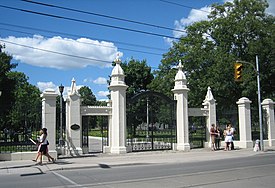Trinity-Bellwoods Park
| Trinity Bellwoods Park | |
|---|---|

The gates at the southern entrance to the park
|
|
| Type | public park |
| Location | Toronto, Ontario, Canada |
| Coordinates | 43°38′52″N 79°24′51″W / 43.64778°N 79.41417°WCoordinates: 43°38′52″N 79°24′51″W / 43.64778°N 79.41417°W |
| Operated by | City of Toronto |
Trinity Bellwoods Park is a public park located in the west end of Toronto, Canada, bordered by Queen Street West on the south and Dundas Street on the north. The western boundary of the park is Crawford Street, several hundred feet before Crawford intersects with Dundas St. West, the park juts toward Shaw Street, westside of the Crawford Street Bridge. Most of the park's area lies in the original Garrison Creek ravine and this creek, now a buried city storm sewer, still flows beneath the park from the northwest to the southeast corners.
The old Garrison Creek emptied into Lake Ontario at the site of Fort York, and the land north and west of the fort was set aside as a military reserve. As the town of York grew around the fort, the military reserve was gradually sold off in lots to retiring British officers and friends of the military command. British Army Lieutenant-Colonel Samuel Smith is said to have bought 1,000 acres (4.0 km2) of land here in 1801, which he called Gore Vale after Lieutenant Governor Francis Gore, the Vale in the name referring to Garrison Creek ravine.
Much of the current park land was originally purchased from a Mrs. Cameron of Gore Vale in 1851 by Scottish-Canadian Bishop John Strachan, an influential Anglican deacon who wanted Toronto to have a private school with strong Anglican ties, partly in opposition to the recently secularized University of Toronto. Buildings were soon constructed (Gothic Revival structure by architect Kivas Tully) and students began attending Trinity College in 1852. After federation with the University of Toronto in 1904 and completion of the downtown Trinity campus in 1925, the school left this location. The original buildings were then sold to the City of Toronto and most were demolished in the early 1950s. The destruction of the Trinity buildings marked the beginning of two decades of extensive heritage destruction in Toronto. Of the college itself, only the stone and iron gates now remain, at the Queen Street park entrance facing south on Strachan Avenue, although the former St. Hilda's College building, (the women's residence of Trinity College) still overlooks the northern half of the park on the western edge. It is now a seniors' residence, John Gibson House.
...
Wikipedia

